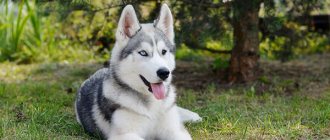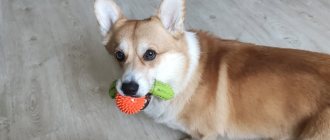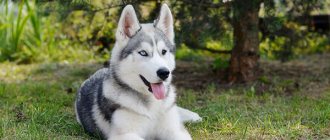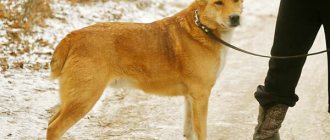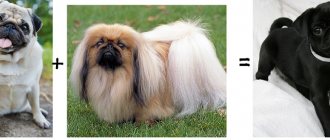This material is dedicated to our daily routine and how and why such a schedule developed: what influenced and influences it, what were the options for the routine, why we eventually left them and what I would like to change in the current state of affairs.
It would seem that this is a banal topic, and what is there to write about: in the morning the dogs walk, then have breakfast, then sleep, then engage in training or other activities, then in the evening they walk again, have dinner and go to bed. But outside the city, it’s not a problem at all: you let him run around in the area, and you go about your business.
But everything is not so simple at all, and even an experienced owner, like me, may find himself in a situation where establishing a daily routine will become a non-trivial task for him for various reasons.
How many times to walk the dog
Even if your dog is a small breed and relieves itself in a litter box at home, regular walks are vital for it. Not to mention large breeds and hunting dogs.
With an adult dog, you need to go outside at least 2 times a day - this is a mandatory minimum. The intervals between satisfying natural needs should not exceed 12 hours. Even a trained dog is unlikely to be able to endure much longer.
However, 2 walks a day are not enough for puppies. Puppies have yet to learn how to restrain themselves; they are taught to do so gradually. At first, the baby is taken out 5-6 times a day or more, ideally after each feeding, and then the number of walks is gradually reduced as they grow older.
Also, a twice-a-day walking regimen is not suitable for energetic dogs, such as huskies, dachshunds, terriers, Dobermans, spaniels, basset hounds, beagles and beagle breeds. These breeds simply need 3-4 daily walks with intense physical activity to maintain a normal physical and emotional state.
If you do not have the opportunity to walk your dog often and for a long time, choose breeds bred specifically for home keeping. Such pets feel good at home; you can go out with them less often, paying attention to their mood. Types of dogs you can walk with once a day or less:
- Yorkshire Terrier;
- Shih Tzu;
- Maltese;
- Pomeranian Spitz;
- chihuahua;
- Japanese chin.
Morality:)
Why did I even decide to write this material? As always, not to teach life and correctness. Every seeker eventually finds his own path. Anyone who is not looking is unlikely to read this text. But because for me, many of the things I write about here became a discovery in the literal sense.
Even the very shift of the focus of the problem from the conditional “dog behaves badly = bad dog” to the plane of “dog behaves badly = try to change its living conditions” already brings something new. I know quite a few dogs whose behavior did not change, despite the fact that they were treated by different specialists. And I know of at least one example where moving out of town not only made the life of a dog with a complex character calmer and more measured, but ultimately changed its behavior in situations in which it previously became poorly controlled. No, this did not make her a dog with a good nervous system. But her life and the life of her owner became better. In the systematic absence of those triggers that turned her life into a nightmare, her overall stress level decreased. And the dog became much calmer, even in those circumstances that previously frightened her immensely, became calmer and friendlier to people whom she was once afraid of.
No, I am not advocating that any dog should be placed in conditions that are ideal for him personally at the expense of the owner's life. I write about how some seemingly insignificant factors can affect your dog's life quite seriously. And the fact that by changing some simple things, such as morale, gait and speed of movement during a walk, providing the dog with better rest and sleep conditions than it currently has, giving it a break from intensive training, you can significantly influence on her moral health.
For me personally, the very fact of knowing that I have done the maximum possible for the physical and moral well-being of my dogs is very important. I assume that there are still people like me and I share my experience, which can help them begin to study the issue more deeply and gain their own experience.
Pet walking schedule
Walking dogs has to be adjusted to the schedule of their owners, and there is nothing wrong with that. Some take long walks with their pet in the morning, others in the evening before bed. And the rest of the walks are shorter, at different times during the day.
Here's what a dog walking schedule might look like:
- 6.30 –7.00 – a short morning walk near the house;
- 14.00–14.20 – short walk in the middle of the day;
- 19.00–20.00 – intensive evening walk with physical activity and games;
- 23.00–23.30 – short walk before bedtime.
This is just an example. Each dog owner sets his own walking schedule, depending on his employment, dog breed, weather conditions and other circumstances. However, there are rules that it is advisable for everyone to follow at all times.
Rule 1
Try not to change the established schedule for walking your dog - pets react poorly to such changes, get worried and can prepare an unpleasant surprise in the apartment (that is, they cannot tolerate it).
Rule 2
One walk a day should be longer, preferably at least 1–1.5 hours. During this walk, you can change the route, go further, in search of new experiences. The dog must receive sufficient physical activity and emotional release.
These are general recommendations for the time, frequency and duration of walks, so do not forget about the individuality of each dog. Like people, our little brothers differ greatly from each other in temperament and character.
There is no need to blindly follow the requirements for a particular breed. Be attentive to your pets, observe their behavior, preferences and habits in order to develop a special walking regime that is comfortable for your dog.
Training and classes
I was never such a disciplined fan of training that my dogs could get tired of it as I thought. However, in this field a few years ago, I discovered that long, complete breaks from training or learning a specific skill produce excellent results with my dogs! Not once during the breaks did any of them roll back; as a rule, I was happy to note the improvements.
There was even a case when Max was unable to learn his now beloved “bunny”. I was forced to stop classes because I was in the hospital. When I returned home, I discovered that a trick that was absolutely impossible for him a week ago was magically working! Such situations were then repeated several times. And I started using this trick.
As soon as the dog and I reach a dead end, it doesn’t matter about technical or motivational issues, I take long (a month or two) breaks from training altogether. And when I return, I always observe progress, not regression. In my opinion, this is also due to the lack of intense anticipation of progress after the break. I always think that now I will need to go back and do some more work, but I am surprised to see that it is not at all. And this charges both me and the dog with positivity. Therefore, I am not a supporter of the “let’s push a little more and it will work” approach, my method is “let’s rest and get bored.”
Walking rules and regulations
We must not forget about the rules and regulations established in society for walking dogs. This is especially true for densely populated urban areas. Follow these simple guidelines:
- walk your dog on a leash and muzzle in crowded places;
- do not walk your dog on playgrounds or near educational or medical institutions;
- Clean up after your dog using a dustpan, bags or napkins.
The lifespan, health and happiness of your dog largely depends on the correct walking regime, which should be taught from puppyhood. If the dog takes full walks, spends enough energy and receives a positive charge, then he will be healthy, friendly and obedient.
Balanced day
Some of these procedures can be combined. Toilet chores, for example, can be combined with physical exercise and games, if the dog’s walking routine allows for this. Never forget to praise and reward your pet for following the regime. When toilet training your dog, reward him and sometimes give him a treat. This will help the pet get used to going to the toilet at a certain time, knowing that the owner will praise him later.
If you set a clear schedule for your dog's activities and stick to it, you will soon notice that caring for your puppy is much easier. Especially when these activities become as much a habit for you as they are for him. Your pet will know that he is cared for and will feel safe in his new environment.
Stages of sleep and dreaming
Four-legged pets, like their owners, dream. This fact was proven by scientists from the University of British Columbia, who compared the results of an EEG (electroencephalogram) of a person and six English pointers. The stages also coincide:
- Slow or deep.
Necessary for restoring the body's strength. Occurs shortly after falling asleep. Accompanied by measured breathing, decreased muscle tone and complete immobility of the eyeballs. When suddenly awakening, the animal needs time to assess the situation and come to its senses.
- Fast or superficial.
Follows immediately after the slow stage. Brain activity at this moment is close to the state of wakefulness, so even a slight rustle is enough to awaken. The main sign is active movement of the eyeballs.
The change from a slow stage to a fast one is called a cycle. During one dream there are from 4 to 6 cycles with short-term wakefulness. It is necessary to change posture so that the body does not have time to become numb from being immobilized for too long.
Direct dreams are observed in both stages. The longest and most emotional ones are typical for fast ones. They are the ones that remain in memory for some time.
INTERESTING!
According to the research of Professor Matthew Wilson from the Massachusetts Institute of Technology, in the deep phase animals experience events that have already occurred, and in the slow phase they experience possible options for their development. They are mainly associated with pursuit and hunting.
When and how do dogs sleep?
The domestic dog is a faithful pet for humans, but traces of its wolf ancestors have not disappeared from its genes. That’s why her sleep structure is the same as theirs.
The wolf sleeps as much as he can afford. In good times, he gets up in the morning, hunts with the pack, eats and goes to bed until the evening. In the evening he wakes up, eats, plays with the flock and goes to bed again until his turn comes to be on duty. When good times give way to bad, the wolf sleeps when he falls exhausted or when he finally manages to catch something.
A dog also sleeps according to the same principle: in good times, it dozes after walking and eating, sleeps deeply at night, so that in the morning it can wake up and go for a walk again.
She sleeps up to sixteen hours a day , and the rest of the time she spends energy and has fun.
Although the actual figure depends, of course, on many factors.
Digestive process in dogs
The assimilation and digestion of food in a four-legged friend differs from similar processes in humans. You cannot calculate the frequency of feeding and menu based on the principles of your own digestive system.
In addition, digestion of food is an individual process for each pet. It depends on various factors. Among the main ones, weight, age, breed, physiological characteristics (estrus, pregnancy, feeding), and physical activity should be highlighted.
The digestion process itself consists of several stages:
- Once in the mouth, food is crushed using teeth - a dog has 42 of them, unlike a person.
- Then the pieces of food are mixed with saliva and easily swallowed. There are times when an animal swallows food whole. Dog saliva, unlike human saliva, does not contain digestive enzymes, so the digestion process starts not in the mouth (as in humans), but in the stomach.
- The lump passes unhindered through the esophagus and enters the stomach.
- Inside the stomach, food combines with enzymes and begins to break down.
- The process of absorption and digestion is finally completed in the intestines. It is important to note that in humans the digestive tract takes up 11% of the total weight, and in dogs it is 7% in small breeds and only 3% in large breeds. This means that the gastrointestinal tract has a greater load.
During digestion, proteins are broken down into amino acids. Fats break down into acids and glycerol, and carbohydrates are transformed into glucose. The dog’s body spends a lot of energy on this.
Due to the fact that the pet's stomach does not have supporting muscles, and saliva does not contain digestive enzymes, it needs long intervals between meals. He should have 3-4 hours of rest after a hearty lunch. Feeding too often is not beneficial for the four-legged dog, and active exercise after a hearty meal is perceived negatively by it.
How many hours a day should puppies sleep?
The child's body spends a large amount of energy on the growth and development of the body. Because of this, babies are less awake than adults.
Less than 3 months
The norm for newborns is 20 hours a day. They wake up only to eat and practically do not react to external stimuli.
INTERESTING!
Newborns sleep 90% of the time, and adult animals only 50%, distributing the remaining 20% and 30% between an active lifestyle and lazy wallowing while maintaining alertness, respectively.
3-6 months
At this age, four-legged pets become more active. By 3 months, they have full control of their body and begin to walk and run, exploring the previously inaccessible world around them. Their sensitivity increases and their reaction improves.
Night sleep becomes more restless and is easily interrupted by loud noise or bright lights. The recommended norm is reduced to 16-18 hours.
More than 6 months
After six months, the most active period of life begins. It lasts up to 1.5 years. The animal’s body becomes more resilient and fully restores the strength spent during the day within 12-14 hours.
Establishing a regime
Building a daily routine begins after the moved animal has completely settled into the new place and gets used to the surrounding environment. This usually happens one to two weeks after the move.
Having a clear schedule makes life somewhat more difficult for the owner, but it also has advantages:
- Strict alternation of nutrition and physical activity eliminates the possibility of obesity and allows you to maintain good physical shape.
- Just make a menu in advance and make sure you get all the products you need for a healthy life. This is especially true for natural pets.
- It is easier to control natural urges in puppies. You know exactly when the animal will need a walk to perform its toilet duties, which means fewer unpleasant surprises await you.
- A clear routine can save lives. As soon as the pet remembers when it is fed daily, it stops picking up all the food available to it on a walk, because it knows that it will definitely be fed after a while. This means that the chance of being poisoned by something spoiled or deliberately scattered by dog hunters drops sharply.
- Attempts to bite and constantly beg for food from others disappear. This habit is found either in very spoiled dogs or in children who are gradually switching to fewer meals. But over time, the animal gets rid of this habit, which means the threat of gaining dangerous weight also decreases.
A clear arrangement of a pet’s daily life schedule depends only on the desire and capabilities of the owner. There are several rules that will make your dog’s life more comfortable and will help you carefully weave new responsibilities into a person’s usual rhythm of life:
- Analyze your life cycle and determine once and for all when is the best time to feed. Keep in mind that a puppy and a pregnant bitch require more feedings than an adult dog during a normal period.
- When deciding at what time you will provide food, consider physiological needs . The dog will want to relieve itself 20-30 minutes after feeding, and will also need a walk after 6-8 hours, provided that the digestive process is normal.
- As soon as the animal matures (usually this happens by the age of 2 years or a little earlier for representatives of small breeds), he will learn to tolerate several hours, but it is still better to accustom him and yourself to a walk immediately after breakfast, because pregnant, sick and old dogs cannot be tolerated. can, which means that when the status changes to a similar one, the pet will experience psychological discomfort due to its behavior.
- Accustom to a clear daily routine gradually and do not change it. Walking and feeding should be timed from the first weeks of the dog's stay in the house. However, the dog itself will get used to the established rules only after 6-7 weeks of observing them. If you yourself regularly break the routine, the animal will never be able to get into the rhythm.
How do dogs behave when they sleep?
The sleeping position of a puppy at one month depends little on his emotional state. The baby falls asleep in any position. It is much more difficult with an adult dog. Cynologists identify several characteristic positions of their pets during sleep:
- Kalachik . A naturally physiological position that a dog takes during sleep if it is cold, uncomfortable, restless, or “just likes it that way.” What prompts your pet to sleep in this particular position will be revealed by careful observations.
- On the back . A pose expressing the highest degree of trust in the owner. The dog will sleep without worrying about the “safety” of internal organs only next to someone he trusts infinitely.
- Pancake – sleeping position on your side with your paws extended forward. Often a tired dog falls asleep in this position.
- Spread out on your stomach . Favorite sleeping position for bulldogs, especially Frenchies. Animals that are hot often fall asleep this way.
Aristotle also wrote that “animals undoubtedly dream.” It is believed that puppies “learn” daytime experiences during sleep. This is indirectly confirmed by observing sleeping dogs that bark, run after someone, attack or run away whining.
What determines how long your pet sleeps?
In addition to age, the following factors influence sleep duration:
- Body size.
The smaller your pet, the faster its body recovers.
- Breed.
Toy breeds and companion dogs sleep the hardest, as they are not designed to guard, herd, or protect livestock from predators.
- Activity level.
After a long walk and active games on the street, the animal always sleeps more and more soundly than usual.
- Excess weight.
With obesity, daytime sleepiness and frequent awakenings are often observed, which negatively affect the dog’s general well-being.
- The weather outside the window.
The longest duration is typical for cloudy weather and cold seasons. This is due to the lack of sunlight, which affects the biological clock.
- Boredom.
If your pet does not know how or does not want to entertain himself, then during your absence or busyness he will sleep.
- Stress.
Occurs when there is an inability to adapt to a specific stimulus. The danger to the body is the chronic form, which develops when nervous tension persists for a long time.
- Presence of diseases.
Infections, parasitosis, pathologies of the heart and kidneys, arthritis and poisoning greatly exhaust the body. They can either increase or decrease the total duration of sleep. These pathologies can be recognized by the accompanying symptoms.
If your pet sleeps for a suspiciously long time, and in addition to lethargy and drowsiness, he is bothered by a high temperature, vomiting or other alarming signs, contact your veterinarian. This condition is not normal and can lead to serious complications if left untreated.

